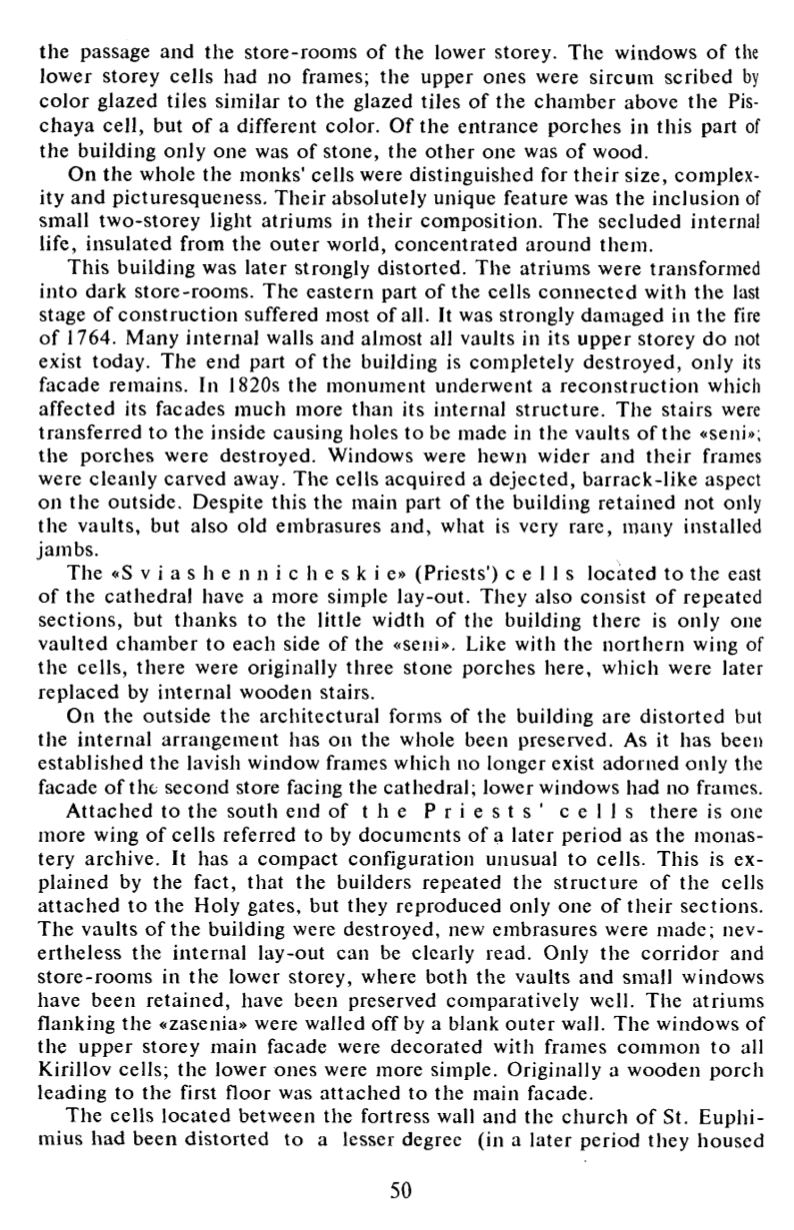

the passage and the store-rooms o f the lower storey. The windows o f the
lower storey cells had no frames; the upper ones were sircum scribed by
co lor glazed tiles similar to the glazed tiles o f the chamber above the Pis
chaya cell, but o f a different color. Of the entrance porches in this part of
the building only one was o f stone, the o ther one was of wood.
On the whole the monks' cells were distinguished for their size, complex
ity and picturesqueness. Their absolutely unique feature was the inclusion of
small two-storey light atriums in their composition. The secluded internal
life, insulated from the outer world, concen trated around them.
This building was later strongly distorted. The atriums were transformed
into dark store-rooms. The eastern part o f the cells connec ted with the last
stage o f construction suffered most o f all. It was strongly damaged in the fire
o f 1764. Many internal walls and almost all vaults in its upper storey do not
exist today. The end part o f the building is completely destroyed, only its
facade remains. In 1820s the monument underwent a reconstruction which
affected its facades much more than its internal structure. The stairs were
transferred to the inside causing holes to be made in the vaults o f the «seni»;
the porches were destroyed. Windows were hewn wider and their frames
were cleanly carved away. The cells acquired a dejected, barrack-like aspect
on the outside. Despite this the main part of the building retained not only
the vaults, but also old embrasures and, what is very rare, many installed
jambs.
The «S v i a s h e n n i с h e s к i e» (Priests') c e l l s located to the east
o f the cathedral have a more simple lay-out. They also consist o f repeated
sections, but thanks to the little width o f the building there is only one
vaulted chamber to each side of the «seni». Like with the northern wing of
the cells, there were originally three stone porches here, which were later
replaced by internal wooden stairs.
On the outside the architectural forms of the building are d istorted but
the internal arrangement has on the whole been preserved. As it has been
established the lavish window frames which no longer exist adorned only the
facade o f the second store facing the cathedral; lower windows had no frames.
A ttached to the south end of t h e P r i e s t s ' c e l l s there is one
more wing o f cells referred to by documents of a later period as the monas
tery archive. It has a compact configuration unusual to cells. This is ex
plained by the fact, that the builders repeated the structure o f the cells
a ttached to the Holy gates, but they reproduced only one o f their sections.
The vaults o f the building were destroyed, new embrasures were made; nev
ertheless the internal lay-out can be clearly read. Only the corridor and
store-rooms in the lower storey, where both the vaults and small windows
have been retained, have been preserved comparatively well. The atriums
flanking the «zasenia» were walled off by a blank outer wall. The windows of
the upper storey main facade were decorated with frames common to all
Kirillov cells; the lower ones were more simple. Originally a wooden porch
leading to the first floor was attached to the main facade.
The cells located between the fortress wall and the chu rch o f St. Euph i
mius had been distorted to a lesser degree (in a later period they housed
50















